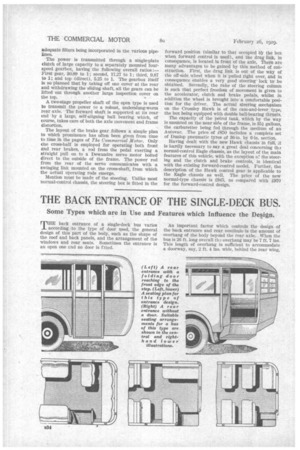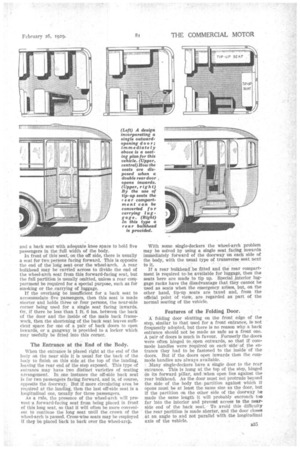THE BACK ENTRANCE OF THE SINGLE-DECK BUS.
Page 60

Page 61

If you've noticed an error in this article please click here to report it so we can fix it.
Some Types which are in Use and Features which Influence the Deign.
TilE back entrance of a single-deck bus varies according to the type of door used, the general design of this part of the body, such as the shape of the roof and back panels, and the arrangement of the windows and rear seats. Sometimes the entrance is an open one and no door is fated.
An important factor which controls the design of the back entrance and •rear vestibule is the amount of overhang of the body beyond the rear axle. When the bus is 26 ft. long overall th3 overhang may be 7 ft. 7 ins. This length of overhang is sufficient to accommodate a doorway, say, 2 ft. 4 ins, wide, behind the rear wing, and a back seat with adequate knee space to hold five passengers in the full width of the body.
In front of this seat, on the off side, there is usually a seat for two persons facing forward. This Is opposite the end of the long seat over the wheel-arch. A rear bulkhead may be carried across to divide the end of the wheel-arch seat from this forward-facing seat, but the full partition is usually omitted, unless a rear compartment be required for a special purpose, such as for smoking or the carrying of luggage.
If the overhang be insufficient for a back seat to accommodate five passengers, then this seat is made shorter and holds three or four persons, the near-side corner being used for a single seat facing inwards. Or, if there be less than 1 ft. 6 ins, between the back of the door and the inside of the main back framework, then the shortening of the back seat leaves sufficient space for one of a pair of back doors to open inwards, or a gangway is provided to a locker which may usefully be fitted into this corner.
The Entrance at the End of the Body.
When the entrance is placed right at the end of the body on the near side it is usual for the back of the body to finish on this side at the top of the landing, leaving the rear end of the step exposed. This type of entrance may have two distinct varieties of seating arrangement. In one instance the off-side back seat is for two passengers facing forward, and is, of course, opposite the doorway. But if more circulating area be required at the landing, then the last off-side seat is a longitudinal one, usually for three passengers.
As a rale, the presence of the wheel-arch will preyenta forward-facing seat from being placed in front of this long seat, so that it will often be more convenient to continue the long seat until the crown of the wheel-arch is passed. Cross-wise seats may be employed if they .be,placed back to back over the wheel-arcia.
With some single-deckers the wheel-arch problem may be solved by using a single seat facing inwards Immediately forward of the doorway on each side of the body, with the usual type of transverse seat next to it.
If a rear bulkhead be fitted and the rear compartment is required to be; available for luggage, then the seats here are made to tip up. Special interior luggage racks have the disadvantage that they cannot be used as seats when the emergency, arises, but, on the other hand, tip-up seats are taxed and, from the official point of view, are regarded as part of the normal seating of the vehicle.
Features of the Folding Door.
A folding door shutting on the front edge of the step, similar to that used for a front entrance, is not frequently adopted, but there is no reason why a back entrance should not be made as safe as a front one. A pair of doors is much in favour. Formerly the doors were often hinged to open outwards, so that if commode handles were required on each side of the entrance they had to be fastened to the inside of the doors, But if the doors open inwards then the commode handles are always available.
Many single-deckers have a single door to the rear entrance. This is hung at the top of the step, hinged On its forward pillar, and when open lies against the rear bulkhead. As the door must not protrude beyond the side of the body the partition against which it opens must be at least the same size as the door, but if the partition on the other side of the doorway be made the same length it will probably encroach too far into the interior and prevent access to the nearside end of the back seat. To avoid this difficulty the rear partition is made shorter, and the door closes at an angle to and not parallel with the longitudinal axis of the vehicle.




















































































































